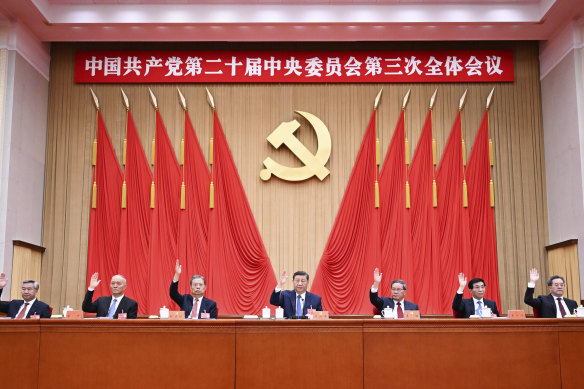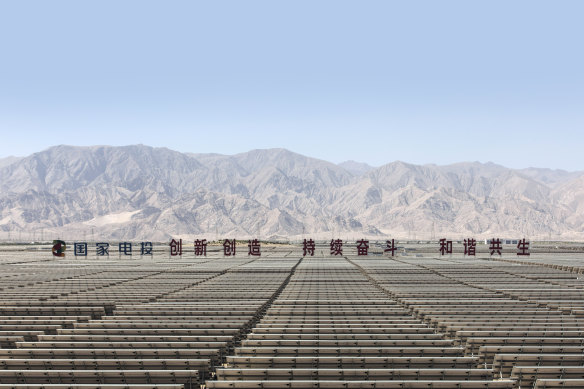Opinion
China’s trade policy is almost a declaration of economic war
By Ambrose Evans-Pritchard
The first China Shock in the 1990s and early 2000s flooded the world with cheap goods and redrew the contours of the global economy.
It let multinationals exploit labour arbitrage, playing off Chinese wages against the wages of blue-collar workers in America and Europe. It lifted both the profit share of GDP and the Gini coefficient of inequality to the highest levels since the Second World War.
It rewarded capital, while the West’s bottom half was left behind, poisoning our democracies. It compounded the brain vs brawn chasm caused by digital tech. It weakened our defences against the mischief of social media.

Optimists had hoped for a change of course at last week’s third plenum. Instead, they got another kick in the stomach.Credit: AP
The emerging China Shock 2.0 is even larger. The Chinese economy is today twice as big as a beast on the global stage as it was in 2007 before the global financial crisis.
Professor Michael Pettis from Peking University says we now have an untenable situation where China produces 31 per cent of the world’s manufactured goods but accounts for just 13 per cent of world consumption. The rest of us have to absorb this imbalance.
China’s soaring exports are not a quirk of nature or because its products are better (some are, most are not). It is the mechanical result of structural policies pursued by the Communist Party with the stubbornness of the Ming dynasty at its worst. This has pushed China’s trade surplus to a record $US100 billion ($151 billion) a month, surpassing the total share of global GDP reached at the peak of the China Shock 1.0.
Eternal optimists had hoped for a change of course at last week’s third plenum, an event held every five years that has set economic strategy ever since Deng Xiaoping embraced capitalist roadsters at the third plenum of 1978. Instead, they got another kick in the stomach.
“There’s nothing new under the sun: the same industrial policies, the same ideas,” said Alicia Garcia-Herrero, chief China watcher for investment banking advisors Natixis. “No consumer-led growth, no mention of market forces, nothing.”
The communiqué exhorts the Chinese people to “persist” 17 times. This means “persisting” with policies that divert a big chunk of the national pie towards state bodies and companies, which are then pushed into chronic overinvestment by warped incentives that defy market price signals but enhance party control.
This structure leaves households with the leftovers, just 37 per cent of GDP, compared to 51 per cent in Germany, 60 per cent in Italy, 62 per cent in the UK, and 68 per cent in the US. It crushes consumption and is the root cause of the Chinese export tsunami.
The imbalance is getting worse, not better. China is reverting to the worst pathologies of its catch-up growth phase a generation ago. It was tolerated back then. It will not be tolerated now.
‘Chinese society is like a pressure cooker that could explode at any time.’
Chen Yingxuan, labour expert at Taiwan’s defence research institute
Beijing has not delivered on its long-promised switch from an investment-led economy to a mature consumption economy. That requires spending on a social welfare blanket so that the Chinese people do not feel compelled to save a third of their income. But this cuts against Xi Thought.
“We cannot engage in welfarism. In the past, high welfare in some populist Latin American countries fostered lazy people who got something for nothing. Their national finances were overwhelmed, and these countries fell into the middle-income trap. Once welfare benefits go up, they never come down,” he said. In his Spartan schema, welfare diverts resources from the global struggle for military and technological dominance.
The Plenum issued the usual pieties about “comprehensively deepening reform”. It tried to reconcile the Leninist state and the capitalist market – the “two unswervings” in the catechism – but it is obvious which has primacy.
Capital Economics said China is digging in its heels on an industrial policy geared ever more towards the national security state, channelling resources to pet sectors and creating further excess capacity. It is also condemning itself to long-term stagnation.
“At the macro level, industrial policy is arguably doing more harm than good, exacerbating demand and supply imbalances, deflationary pressures and financial strains,” it said.
“The package is not coherent,” said Dan Rosen, from the Centre for International Strategic Studies. “It doubles down on policies raising alarm bells globally about China’s growth model. Nothing is offered to stimulate sputtering domestic demand and narrow China’s gaping trade surpluses. It will generate more trade conflict.”
China is the victim of its own strategy. It is already in a classic liquidity trap. Credit demand is falling because people are battening down the hatches and paying off debt. The central bank (PBOC) can no longer gain traction by relaxing credit curbs.
It is wary of slashing interest rates for fear of pushing banks over the edge, and fear that capital outflows could lead to a currency crisis akin to 2015-2016. “The heavy lifting will need to come from fiscal policy,” said Capital Economics.
That is not easy either. The International Monetary Fund says China’s “augmented” fiscal deficit is 14 per cent of GDP, once you include off-budget vehicles in the regions. The augmented debt is 116 per cent of GDP.
Local governments raised half their revenues from land sales before the property bubble burst. This funding has collapsed, leaving them in various states of insolvency.
Professor Victor Shih, director of the 21st Century China Center in San Diego, says 12 of the 31 provinces have monthly debt service costs that exceed their monthly income, and all but four were over 50 per cent. By the end of 2022 the debt service ratio had reached 200 per cent in Tianjin, 188 per cent in Jilin, 176 per cent in Guizhou, and so on.
Prof Shih says “shadow” finance may have pushed local government debt alone to $US15 trillion, or 90 per cent of GDP. If so, underlying debt dynamics in China are on a par with Greece, and catching up with Japan. Beijing is issuing special bonds to keep local government afloat, but it dares not launch bazooka-scale stimulus.
Local governments are cutting the wages of civil servants to make ends meet. They are issuing “tight life” regulations to official agencies and bodies. Banks are retrenching too.
The China International Trust Investment Corporation (CITIC) has cut its base wages by around 25 per cent this year. State-owned lenders are cutting by 20 per cent to 30 per cent, with performance reviews now becoming ritual torture for employees. The “big four” accounting firms will start cutting in August.
Pervasive angst is spreading through the middle class, hitherto shielded from the bouts of austerity dished out to migrant workers when times are hard. They borrowed to the hilt to get on the property ladder but are now caught in the double vice of falling incomes and falling home prices.
“Chinese society is like a pressure cooker that could explode at any time,” said Chen Yingxuan, a labour expert at Taiwan’s defence research institute.
The deeper the country sinks into its post-Minsky funk of debt-deflation and consumer retrenchment, the greater the trade shock for the rest of the world. Chinese companies are having to flog their wares on the global market at cut-throat prices to stay alive.

A solar power station on the outskirts of Golmud, Qinghai province. China’s production capacity for solar modules has risen from 337 to 1,405 gigawatts since 2021.Credit: Getty
You could say that China’s rampant overinvestment is at least helping to solve one problem. China is rolling out renewable energy and EVs so fast that it gives the world a chance of stopping runaway climate change. Carbon Brief says its CO2 emissions probably peaked last year, seven years ahead of schedule.
China production capacity for solar modules has risen from 337 to 1,405 gigawatts since 2021 – over 80 per cent of the world’s total – leading to a global glut and fall in prices to near $US0.10 per watt. Solar panels are now so cheap across Africa and South Asia that they entirely change the calculus of electricity projects.
Imports of solar panels and batteries from China displaced two gigawatts of utility coal power in South Africa alone last year – the solution to blackouts. The gain accrues to the importer, not to the Chinese exporter, who receives a pittance for his labour and capital.
But China’s excesses are not confined to the green trio of solar, batteries, and EVs. The country is flooding the world with everything. Over 70 per cent of the Chinese cars bursting on the global market are not EVs. They are combustion engine cars escaping excess capacity at home.
Furthermore, China is not making way for other developing countries as it goes up the technology ladder – “shedding” in trade jargon. It is increasing its exports of cheap, low-tech goods as well. Chinese mercantilism is as much a menace to the Global South as it is to the North.
Commerce with China does not meet Adam Smith’s conception of free trade in the Wealth of Nations. Beijing aims to demolish rivals and achieve monopolistic hegemony across entire sectors. Trade has a predatory edge and is being mobilised for ideological warfare against democracies.
The third plenum lays the matter bare. Xi clearly has no intention of changing course.
The Business Briefing newsletter delivers major stories, exclusive coverage and expert opinion. Sign up to get it every weekday morning.